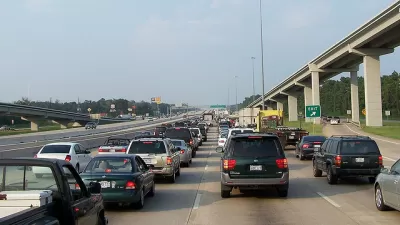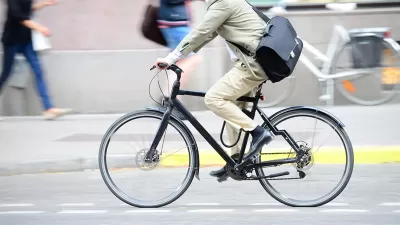Not long ago, I posted on what makes some cities more stressful than others. (See http://www.planetizen.com/node/40441 ). In that post, I remarked that the ideal objective indicia of stress (resident surveys on crime, illness, etc.) often do not exist for most cities.
Not long ago, I posted on what makes some cities more stressful
than others. (See http://www.planetizen.com/node/40441
). In that post, I remarked that the
ideal objective indicia of stress (resident surveys on crime, illness, etc.)
often do not exist for most cities.
It occurred to me that it might be useful to talk about more
subjective indicators- if only to see if other people think about the same
things that I think about. I have lived
in ten cities since graduating from law school 23 years ago (not counting Toronto,
where I have lived for a grand total of two weeks). By far, Miami
was the most stressful of those cities, with Atlanta
a distant second; the two small towns I have lived in (Carbondale,
Illinois and Fort
Smith, Arkansas) the least. The other cities I have lived in (St.
Louis, Buffalo,
Cleveland, Jacksonville,
Washington, and Philadelphia)
have been somewhere in between.
What
made Miami so awful for me?
*The combination of traffic congestion and car
dependence. I find nasty traffic to be
stressful, and I find having to drive in such nasty traffic to be even more
so. To a much greater extent than any
other city I have lived in, Miami combined
rough traffic with public transit that was inadequate to my needs. Atlanta
has even more extensive traffic; however, for most of my time in Atlanta,
I did not have to drive every day. Washington,
by contrast, has traffic even worse than Miami
or Atlanta- but since I did not own
a car I was insulated from this problem.
At the other end of the spectrum, in Carbondale
I could walk from one end of town to the other in two hours- truly a commuter's
ideal.
*Crime, or more precisely the perception of crime. In Miami,
I lived a few blocks from the Brickell subway stop. But rightly or wrongly, I did not feel safe
walking from that subway to my apartment after dark – which in turn meant that when I worked late, I had
to drive through the heavy traffic mentioned above. By contrast, in Carbondale
and Fort Smith I worried very
little about crime. In the "in between"
big cities, crime was obviously higher than in Carbondale or Fort Smith- but I
thought that most of the areas that I walked through on a regular basis were
safer than downtown Miami seemed to be in the early 1990s. Having said that, I emphasize that my stress
came from the perception of crime: I have no idea whether, statistically
speaking, the area around the Brickell subway stop was really more dangerous than
my neighborhoods in other cities.
Of course, my experience teaches me that congestion, crime, and car dependence are important. But also, it teaches me that it is impossible to generalize about a city being stressful for everyone. For example, if I had lived in a distant Washington suburb and had to drive to the city (or even to a Metro stop) I would have experienced Washington as a very stressful place. Conversely, if my Miami job had been closer to my apartment, I might have viewed Miami a bit more positively.

Study: Maui’s Plan to Convert Vacation Rentals to Long-Term Housing Could Cause Nearly $1 Billion Economic Loss
The plan would reduce visitor accommodation by 25,% resulting in 1,900 jobs lost.

North Texas Transit Leaders Tout Benefits of TOD for Growing Region
At a summit focused on transit-oriented development, policymakers discussed how North Texas’ expanded light rail system can serve as a tool for economic growth.

Using Old Oil and Gas Wells for Green Energy Storage
Penn State researchers have found that repurposing abandoned oil and gas wells for geothermal-assisted compressed-air energy storage can boost efficiency, reduce environmental risks, and support clean energy and job transitions.

Private Donations Propel Early Restoration of Palisades Playground
Los Angeles has secured over $1.3 million in private funding to restore the Pacific Palisades playground months ahead of schedule, creating a modern, accessible space that supports community healing after recent wildfires.

From Blight to Benefit: Early Results From California’s Equitable Cleanup Program
The Equitable Community Revitalization Grant (ECRG) program is reshaping brownfield redevelopment by prioritizing projects in low-income and environmental justice communities, emphasizing equity, transparency, and community benefits.

Planting Relief: Tackling Las Vegas Heat One Tree at a Time
Nevada Plants, a Las Vegas-based nonprofit, is combating the city’s extreme urban heat by giving away trees to residents in underserved neighborhoods, promoting shade, sustainability, and community health.
Urban Design for Planners 1: Software Tools
This six-course series explores essential urban design concepts using open source software and equips planners with the tools they need to participate fully in the urban design process.
Planning for Universal Design
Learn the tools for implementing Universal Design in planning regulations.
Ascent Environmental
Borough of Carlisle
Institute for Housing and Urban Development Studies (IHS)
City of Grandview
Harvard GSD Executive Education
Toledo-Lucas County Plan Commissions
Salt Lake City
NYU Wagner Graduate School of Public Service





























